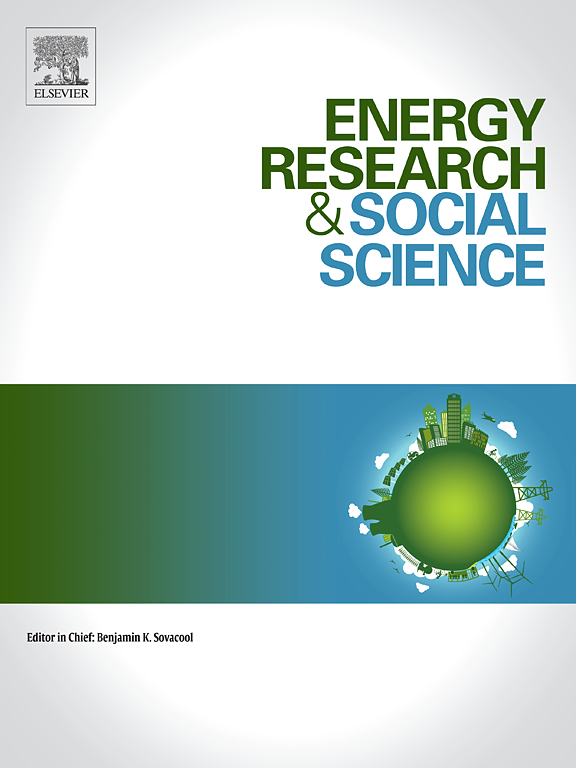The uncanny underground: Psychological and cultural associations of subterranean technologies for climate mitigation
IF 7.4
2区 经济学
Q1 ENVIRONMENTAL STUDIES
引用次数: 0
Abstract
Public perceptions of subterranean renewable energy technologies are shaped not only by technical and environmental considerations but also by deep-seated psychological and cultural associations with the underground. We posit the concept of the “uncanny underground” to describe how interpretations of the subsurface blur boundaries between the familiar and the strange, evoking both curiosity and unease. To explore this phenomenon, we analyze free associations people make with the deep underground, using data collected from a cross-national survey on deep geothermal systems with participants from the US (n = 1003) and Switzerland (n = 1028). While approximately half of the associations describe the physical properties of the underground (e.g., heat, depth, geological structures), a substantial portion reflect symbolic and emotional themes often in the form of dualisms, including: life and death, safety and threat, past and future, and the known and unknown. These associations frequently draw from cultural narratives and symbolic meanings such as burial and the underworld, subterranean adventure stories (e.g., Jules Verne's Journey to the Center of the Earth), and disaster imagery (e.g., The Core). Our findings support research showing that public attitudes towards deep geothermal and other subsurface technologies are shaped by not only technical or economic considerations but also unconscious, culturally embedded meanings that a lifetime of experience and learning create. Understanding how these meanings influence people's perceptions of what we call the “uncanny underground” provides valuable insight into how individuals might react to subterranean energy technologies aimed at addressing climate change.
神秘的地下:缓解气候变化的地下技术的心理和文化联系
公众对地下可再生能源技术的看法不仅受到技术和环境因素的影响,而且受到与地下的根深蒂固的心理和文化联系的影响。我们提出了“神秘地下”的概念,以描述对地下的解释如何模糊熟悉与陌生之间的界限,唤起好奇心和不安。为了探索这一现象,我们分析了人们与地下深处的自由联系,使用了来自美国(n = 1003)和瑞士(n = 1028)的参与者对深层地热系统进行的跨国调查收集的数据。虽然大约一半的关联描述了地下的物理特性(例如,热量、深度、地质结构),但很大一部分通常以二元论的形式反映了象征性和情感主题,包括:生命与死亡、安全与威胁、过去与未来、已知与未知。这些联想通常来自文化叙事和象征意义,如埋葬和地下世界、地下冒险故事(如儒勒·凡尔纳的地心之旅)和灾难意象(如《地心》)。我们的研究结果支持了一项研究,该研究表明,公众对深层地热和其他地下技术的态度不仅受到技术或经济因素的影响,还受到终身经验和学习创造的无意识的文化内涵的影响。了解这些含义如何影响人们对我们所谓的“神秘地下”的看法,有助于了解个人对旨在应对气候变化的地下能源技术的反应。
本文章由计算机程序翻译,如有差异,请以英文原文为准。
求助全文
约1分钟内获得全文
求助全文
来源期刊

Energy Research & Social Science
ENVIRONMENTAL STUDIES-
CiteScore
14.00
自引率
16.40%
发文量
441
审稿时长
55 days
期刊介绍:
Energy Research & Social Science (ERSS) is a peer-reviewed international journal that publishes original research and review articles examining the relationship between energy systems and society. ERSS covers a range of topics revolving around the intersection of energy technologies, fuels, and resources on one side and social processes and influences - including communities of energy users, people affected by energy production, social institutions, customs, traditions, behaviors, and policies - on the other. Put another way, ERSS investigates the social system surrounding energy technology and hardware. ERSS is relevant for energy practitioners, researchers interested in the social aspects of energy production or use, and policymakers.
Energy Research & Social Science (ERSS) provides an interdisciplinary forum to discuss how social and technical issues related to energy production and consumption interact. Energy production, distribution, and consumption all have both technical and human components, and the latter involves the human causes and consequences of energy-related activities and processes as well as social structures that shape how people interact with energy systems. Energy analysis, therefore, needs to look beyond the dimensions of technology and economics to include these social and human elements.
 求助内容:
求助内容: 应助结果提醒方式:
应助结果提醒方式:


